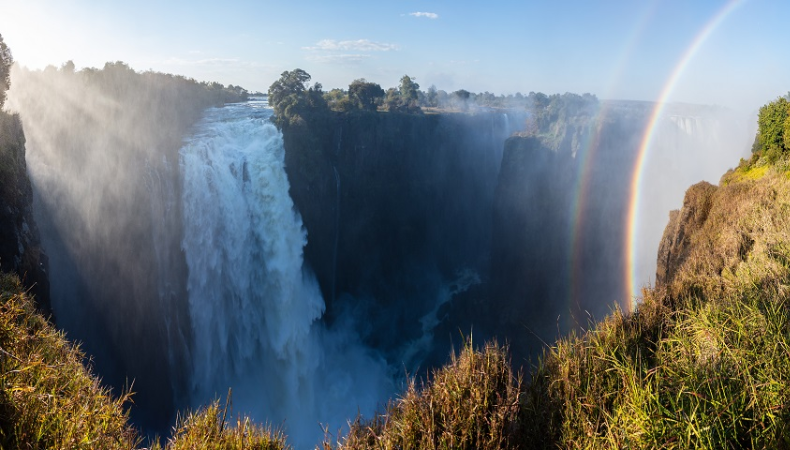Zambia’s untouched environment provides an unparalleled, up-close animal experience with a walking safari. Zambia’s national parks including South Luangwa and Lower Zambezi are renowned for being the birthplace of walking safaris and offer outstanding opportunities to get up close and personal with nature.
Under the direction of knowledgeable local guides who provide valuable information on species and ecosystems, these safaris promote ecotourism and conservation. Zambia’s varied landscapes which range from rocky valleys to riverine regions, guarantee that every walking safari is a unique, instructive and breathtaking experience that promotes a strong bond between tourists and the African wild.
Rich Biodiversity:
Zambia is rich in biodiversity and natural resources. There are an estimated 490 fish species, 242 animals, 757 birds, 74 amphibians, 156 reptiles and 3,543 species of wild flowering plants in the nation. The establishment of protected areas has been Zambia’s primary method of biodiversity conservation. Among other things, Zambia has created 40 Game Management Areas, 20 National Parks and more than 480 forest reserves. An estimated 37.8% of the nation’s total land area is covered by the protected area network. Wetlands, forests and agro-ecosystems are Zambia’s most important ecosystems for rural livelihoods and the country’s economy.
Zambia’s rural population depends on its rich ecosystem for their livelihoods. This is particularly true for the 68% of Zambians living below the poverty line which includes rural areas that rely on agricultural land, food and energy from natural ecosystems.
Sustainable Practices:
The Republic of Zambia’s government has various sustainable plans and also promotes climate smart agriculture, water harvesting and green infrastructure.
With four main pillars of resilient and climate compatible growth, increased resource efficiency, increased natural capital and improved inclusivity is the National Green Growth Strategy which is a comprehensive framework created to match Zambia’s development paths with sustainability principles.
The World Bank-funded Zambia Integrated Forest Landscape Project (ZIFLP) encourages climate-smart agriculture through carbon finance. The project’s objectives are to lower emissions, enhance soil health and restore forests.
The SAFE initiative aims to use forests sustainably and reduce deforestation. At the COP27 UN Climate Change Conference, Zambia signed a memorandum of agreement for the EU Forest Partnerships.
Adventure Activities:
One of Africa’s most renowned hubs for adventure and extreme sports is Zambia which is also known for its breathtaking national parks and landscapes. Each year tourists from all over the world go to the Victoria Falls region for a variety of action-packed activities.
The rainy season in Zambia lasts from November to April. The majority of the activities are offered all year long with the possible exception of Helicopter and microlight flights over the Victoria Falls, Livingstone Island and Devil’s Pool, White-water rafting, Bridge activities like bungee jumping and abseiling, Under spray tour which depends on the water levels and weather on that particular day.
Some other activities which are available throughout the year would be Livingstone Museum, River Rafting, Abseiling, George Swinging, Horse trails, Kayaking, River boarding, etc.
Cultural Experiences:
Dance and music are essential components of Zambian culture. Many initiation ceremonies in Zambian society include drumming and dancing. A key component of local music is the mbira, a thumb piano. After almost going extinct in the 1930s, it returned in the 1960s and is currently well-liked on the global music scene. The bustling marketplaces where ordinary Zambians gather and purchase are the ideal places to witness culture.
For a really authentic look into traditional Kunda life visit Kawaza Village which is located next to South Luangwa National Park. This is an amazing experience that truly captures the essence of authentic African village life. Similar to this, spending a few days in Shiwa Ngandu in northeastern Zambia will offer the opportunity to meet modern Zambians and learn about their lives and struggles in addition to gaining insight into the nation’s colonial past.
Accessibility and Infrastructure:
Digital infrastructure as of 2024, there were 11.4 million active internet users in Zambia indicating an increase in internet availability. The growing number of mobile broadband networks and the availability of reasonably priced internet services are the causes of this growth. But there are still gaps in technology, particularly among women, girls and the elderly as well as in rural areas.
Moving around the most economically significant cities in Zambia have excellent rail and road connections. However, excessive rainfall and climate change are causing serious damage to roads and bridges.
In Zambia it is impossible for persons with disabilities to access public facilities, houses and streets. Elevators of the Bank of Zambia for instance, are located on the ground floor but do not stop at the first floor.
There is a small domestic air transport industry in Zambia that has difficulties due to its aged fleet of aircraft. Zambian Airways unexpected closure has sparked concerns about the local market’s future.
In conclusion Zambia is known as one of Africa’s safest travel destinations. Despite having seventy-three different ethnic groupings, Zambians live in peace and harmony. The foundation of Zambian tourism is ecotourism which elevates Zambia to the status of the newest tourist attraction.

